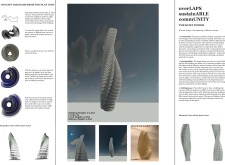5 key facts about this project
Unique Design Approach and Functionality
The Kurt Tower's distinguishing feature is its focus on multipurpose functionality, which allows it to serve various community needs. Each floor encompasses both residential and commercial spaces, enabling the building to adapt to different usage requirements over time. The design encourages social interaction through the inclusion of communal areas and balconies, enhancing user experience and promoting a sense of community. The incorporation of open spaces facilitates natural light penetration, enriching the living environment while maintaining visual connectivity between outdoor and indoor areas.
The structural envelope features materials such as glass, reinforced concrete, and metal elements, which are carefully selected to optimize performance and aesthetic appeal. This materiality not only supports the building's structural integrity but also engages with its urban context. The glass facade enhances visibility and creates a transparent aspect, blurring the lines between the interior and exterior.
Environmental Considerations and Energy Efficiency
The Kurt Tower places a strong emphasis on sustainability and environmental stewardship. The architectural design incorporates features that harness solar energy and allow for efficient climate responsiveness. The balconies are designed to collect rainwater and utilize natural light effectively, minimizing reliance on artificial lighting and mechanical systems. This approach exemplifies the integration of design and function, ensuring that the building actively contributes to its ecological surroundings.
The spiral form of the tower serves not just an aesthetic purpose but also enhances air circulation, which is crucial for thermal comfort. The innovative design strategies reflect the architects' commitment to creating an environmentally responsible structure that fosters a sense of interaction within the community.
For further insights into the architectural plans, sections, and overall architectural designs of the Kurt Tower, interested readers are encouraged to explore the project presentation for a comprehensive understanding of its features and conceptual underpinnings.























